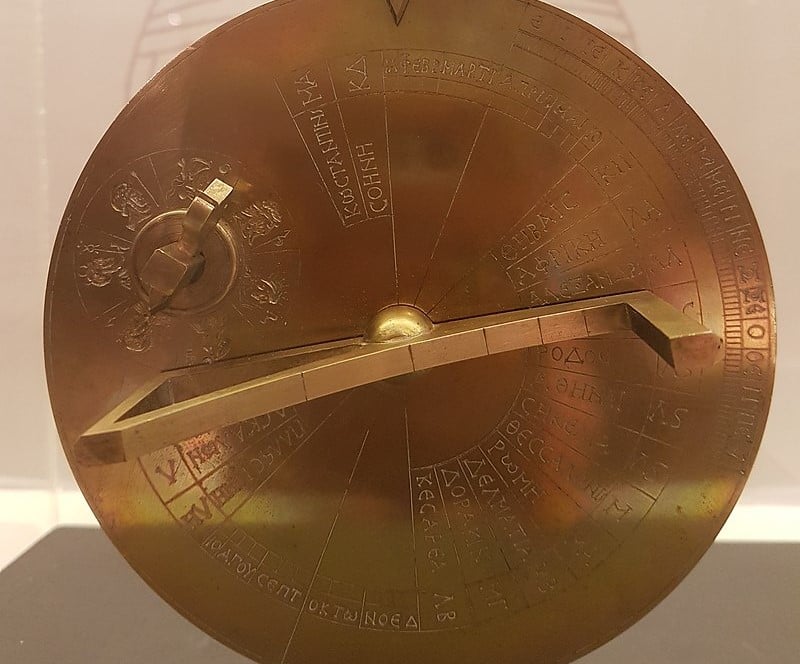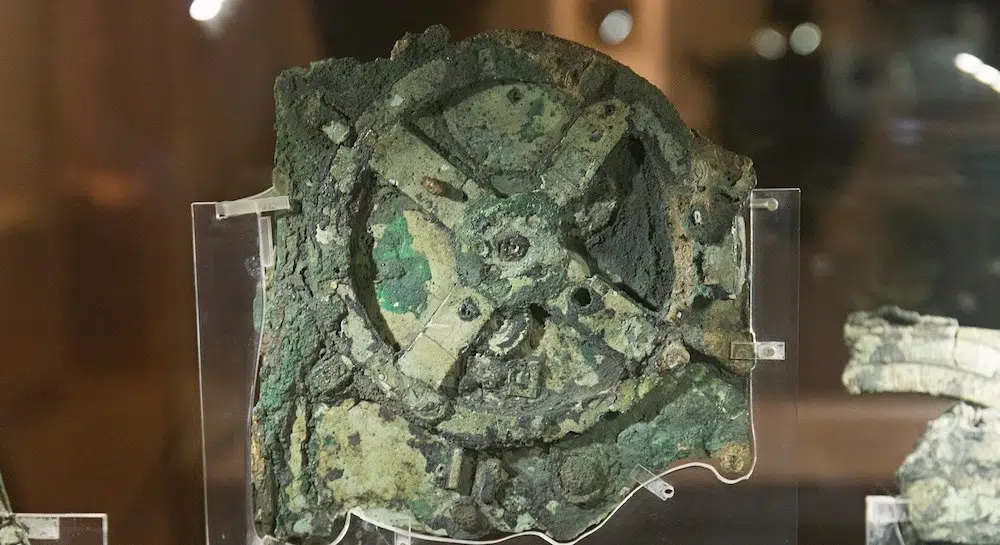
Referred to as the Byzantine “Antikythera Mechanism”, the portable sundial-calendar on display at the London Science Museum is fifteen centuries old and is proof that the Byzantines excelled in arithmetic and astrology.
Byzantine education was based on the study of the trivium and quadrivium, a program codified by the Romans. Its elements were inherited from late Ancient Greece.
The trivium was the study of grammar, logic, and rhetoric. The quadrivium was the study of arithmetic, astronomy, music, and geometry.
Educated Byzantines clearly distinguished between astronomy and astrology, the former being concerned with the theoretical study of celestial events, whereas the latter functioned as a practical art.
The Byzantine sundial-calendar
The Byzantine sundial-calendar in the London Science Museum consists of four surviving parts: the front sundial plate, suspension arm, Moon disc with gear, and arbor with ratchet and two well-formed gear wheels.
The handle measures 127 mm x 30 mm x 18 mm, while the gear wheel is 28 mm x 32 mm, and the plate is 3 mm x 135 mm.
Scientists agree that the rare artifact was created during the Byzantine Empire era between the years 400 and 600 AD by an unknown individual.
On the sundial plate, there are sixteen inscriptions in Greek, namely: Constantinople, Syene, Thebaid, Africa, Alexandria, Antioch, Rhodes, Athens, Sicily, Thessaloniki, Rome, Dalmatia, Doclea, Caesarea Sratonis, Palestine, and Ascalon.
The Byzantine owner of the device would have been able to use it as a sundial to tell the time in sixteen different locations across the Old World. The well-preserved artifact could be the first portable clock ever.
Furthermore, the owner would have been able to predict the positions of the Sun and Moon in the zodiac and the lunar phases.
Sundial Calendar and Antikythera Mechanism
The device, consisting of a sundial and geared mechanical calendar, is the second oldest known of its kind. The earliest known example is the Antikythera Mechanism.

The Antikythera Mechanism was an Ancient Greek mechanical device used to calculate and display information pertinent to astronomical phenomena. Its construction is currently dated to 100 BC, give or take thirty years.
The elaborate device carried the first known set of scientific dials or scales, and its importance was acknowledged when radiographic images indicated that the remaining fragments contained thirty gear wheels.
No other geared mechanism of such complexity is known to have existed prior to the Antikythera Mechanism. Such mechanisms appeared in medieval cathedral clocks that were built a thousand years later.
Scientists dubbed it an ancient “computer,” and it is named after the island of Antikythera in the Aegean Sea where it was discovered. It is now on display in the National Archaeological Museum in Athens.
Telling time with a sundial
The clock, just like the Antikythera Mechanism, can “display” the time and day in sixteen different cities-regions of the then known world in Greek.
It is a masterpiece, based on deep knowledge of astronomy, mathematics, and technological achievements, such as metalworking, automation, and gear construction.
The owner of the sundial is unknown, but it is likely it was an individual who was part of the priesthood and needed to know the time so as to properly schedule religious rituals.
The concept of an hour, comprised of sixty minutes and three thousand six hundred seconds, is a human invention. However, the Sun would have been instrumental in defining this.
As the Sun navigates across the sky, shadows cast by objects change in length and direction, and if an object is placed on the ground, the shadows can be used to chart the passage of day. By scratching lines into the earth, our ancestors could formulate an ‘hours’ system and begin to count the passing of daylight hours for the very first time.
Hence, the sundial is essentially a time-finder.
The oldest known sundial dates from the reign of Thutmose III, who ruled Egypt around 1500 BC.
It is a simple L-shaped piece of stone with hour lines along its upper surface. At dawn, it would have been aligned towards the rising Sun, and a bar mounted atop the short part of the L would have cast a shadow on the first hour line of the day.
As the Sun moved, the shadow also did along the hour lines until noon when the direction of the sundial was reversed and the same six hour lines were used to count out the afternoon hours.
Greek and Roman Portable Sundials
There are eight portable sundials of a single type, according to J.V. Field and M.T. Wright, who are science historians. Five are inscribed in Greek and three in Roman.
The Greek ones include the sundial part of a compound instrument that has been termed The Byzantine Sundial-Calendar. They all were created during the early centuries of the second millennium and may belong to the Roman era or early Byzantine Empire.
The dial is capable of continuous adjustment for latitude. These dials, like all Ancient Greek or Roman ones, were intended to indicate the time of day according to the system of ‘temporal,’ ‘seasonal,’ or unequal hours, whereby the period from sunrise to sunset each day is equally divided into twelve hours.
What is remarkable about this design in comparison to others from antiquity is that its design embodies an approximation.
The list of Greek sundials also contains a dial from Memphis, information about which has been very scarce thus far. Some authors even considered it lost.
However, this instrument is stored in the collection of the State Hermitage Museum in Saint Petersburg. There is now an opportunity to study it more closely.
See all the latest news from Greece and the world at Greekreporter.com. Contact our newsroom to report an update or send your story, photos and videos. Follow GR on Google News and subscribe here to our daily email!



